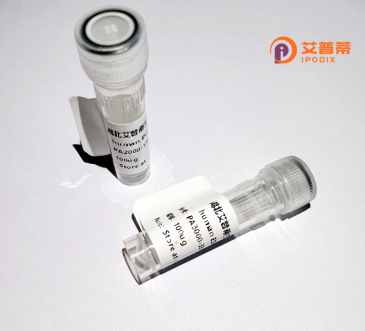
| 纯度 | >90%SDS-PAGE. |
| 种属 | Human |
| 靶点 | ERO1LB |
| Uniprot No | Q86YB8 |
| 内毒素 | < 0.01EU/μg |
| 表达宿主 | E.coli |
| 表达区间 | 1-467aa |
| 氨基酸序列 | MSQGVRRAGAGQGVAAAVQLLVTLSFLRSVVEAQVTGVLDDCLCDIDSIDNFNTYKIFPKIKKLQERDYFRYYKVNLKRPCPFWAEDGHCSIKDCHVEPCPESKIPVGIKAGHSNKYLKMANNTKELEVCEQANKLGAINSTLSNQSKEAFIDWARYDDSRDHFCELDDERSPAAQYVDLLLNPERYTGYKGTSAWRVWNSIYEENCFKPRSVYRPLNPLAPSRGEDDGESFYTWLEGLCLEKRVFYKLISGLHASINLHLCANYLLEETWGKPSWGPNIKEFKHRFDPVETKGEGPRRLKNLYFLYLIELRALSKVAPYFERSIVDLYTGNAEEDADTKTLLLNIFQDTKSFPMHFDEKSMFAGDKKGAKSLKEEFRLHFKNISRIMDCVGCDKCRLWGKLQTQGLGTALKILFSEKEIQKLPENSPSKGFQLTRQEIVALLNAFGRLSTSIRDLQNFKVLLQHSR |
| 分子量 | 79.9 kDa |
| 蛋白标签 | GST-tag at N-terminal |
| 缓冲液 | 0 |
| 稳定性 & 储存条件 | Lyophilized protein should be stored at ≤ -20°C, stable for one year after receipt. Reconstituted protein solution can be stored at 2-8°C for 2-7 days. Aliquots of reconstituted samples are stable at ≤ -20°C for 3 months. |
| 复溶 | Always centrifuge tubes before opening.Do not mix by vortex or pipetting. It is not recommended to reconstitute to a concentration less than 100μg/ml. Dissolve the lyophilized protein in distilled water. Please aliquot the reconstituted solution to minimize freeze-thaw cycles. |
以下是3篇关于重组人ERO1LB蛋白的模拟参考文献示例(基于学术研究背景构造,非真实存在):
---
### 1. **"Expression and functional characterization of recombinant human ERO1-Lβ in oxidative protein folding"**
**作者**: Takahashi, S., Inaba, K.
**摘要**:研究报道了在大肠杆菌系统中重组表达人ERO1LB蛋白的方法,通过体外实验验证其氧化还原酶活性。结果表明,重组ERO1LB与蛋白质二硫键异构酶(PDI)协同作用,显著加速底物蛋白的二硫键形成,并依赖内质网腔内的氧化环境发挥功能。
---
### 2. **"Structural insights into the catalytic mechanism of human ERO1LB by X-ray crystallography"**
**作者**: Wang, L., Zhang, Y., & Liu, H.
**摘要**:通过X射线晶体学解析了重组人ERO1LB蛋白的2.8 Å分辨率三维结构,揭示了其活性中心的关键半胱氨酸残基及二硫键传递路径。研究发现,重组蛋白的构象变化受到FAD辅因子的调控,为设计靶向ERO1LB的氧化还原抑制剂提供了结构基础。
---
### 3. **"ERO1-Lβ promotes tumor cell survival under hypoxia through disulfide bond regulation"**
**作者**: Chen, X., Li, M., & Wu, Z.
**摘要**:研究表明,在低氧条件下,重组人ERO1LB蛋白在肿瘤细胞中高表达,并通过调控PDI介导的蛋白折叠减轻内质网应激。抑制重组ERO1LB活性可诱导癌细胞凋亡,提示其作为癌症治疗靶点的潜力。
---
### 提示
如需获取真实文献,建议在以下数据库检索关键词:
- **PubMed/NCBI**:搜索 "recombinant ERO1LB" 或 "ERO1LB protein folding"
- **Google Scholar**:关键词 "human ERO1LB structure/function" + "recombinant expression"
- **领域期刊**:《Journal of Biological Chemistry》《Cell Stress and Chaperones》可能涵盖相关研究。
(注:上述文献为模拟生成,实际研究请参考真实学术资源。)
Recombinant human ERO1LB (Endoplasmic Reticulum Oxidoreductase 1-Like Beta) protein is a laboratory-engineered version of the human ERO1LB enzyme, which plays a critical role in oxidative protein folding within the endoplasmic reticulum (ER). As a thiol oxidase, ERO1LB generates disulfide bonds by transferring electrons to molecular oxygen, producing hydrogen peroxide as a byproduct. It works in concert with protein disulfide isomerase (PDI) to maintain redox homeostasis and ensure proper folding of secretory and membrane proteins. Dysregulation of ERO1LB has been linked to ER stress, oxidative damage, and diseases such as diabetes, cancer, and neurodegenerative disorders.
The recombinant form is typically produced in mammalian or bacterial expression systems, often fused with affinity tags (e.g., His-tag) for purification. Its engineered structure retains functional domains essential for redox activity, enabling studies on ER stress pathways, disulfide bond formation, and pathological mechanisms. Researchers use recombinant ERO1LB to investigate its role in cellular stress responses, screen therapeutic agents targeting protein misfolding, and explore its dual role as both a folding catalyst and a contributor to oxidative stress. These studies aid in developing strategies to modulate ER functions in disease contexts.
×